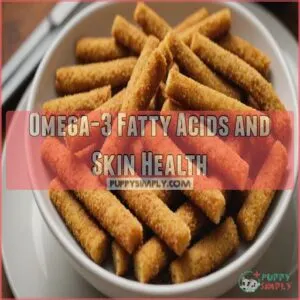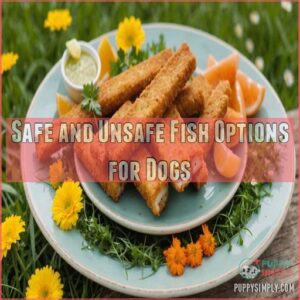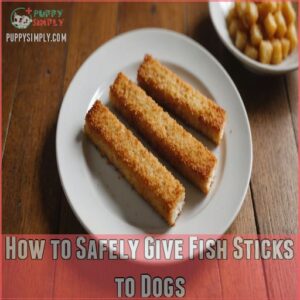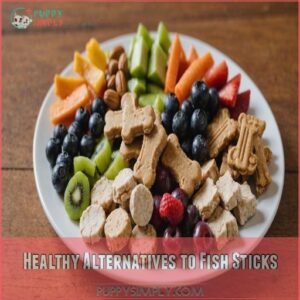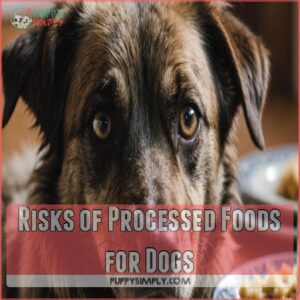This site is supported by our readers. We may earn a commission, at no cost to you, if you purchase through links.

While they might eye your plate with hope, you’re better off saving those tasty tidbits for yourself. Fish sticks are loaded with oils, fats, and salts that can upset your dog’s tummy and even lead to more serious issues like pancreatitis. Plus, the breading often hides seasonings and additives that aren’t exactly puppy-friendly. It’s like offering a treat wrapped in mystery ingredients!
To keep your furry friend safe and healthy, consider giving them plain, cooked fish instead. Curious about safer fishy options and tasty alternatives? Stick around for some fin-tastically helpful tips!
Table Of Contents
- Key Takeaways
- Risks of Fish Sticks for Dogs
- Benefits of Fish for Dogs
- Safe and Unsafe Fish Options for Dogs
- What Are The Ingredients of Fish Sticks
- How to Safely Give Fish Sticks to Dogs
- Healthy Alternatives to Fish Sticks
- Risks of Processed Foods for Dogs
- Frequently Asked Questions (FAQs)
- Can dogs eat fish sticks?
- Are fish sticks toxic to dogs?
- Can dogs eat too much fish?
- Can dogs eat breaded fish?
- What happens if my dog eats a fish stick?
- Can my dog eat seafood sticks?
- Can dogs eat frozen fish fillets?
- Are fish sticks safe to eat?
- How do fish sticks affect dog weight?
- Are fish sticks suitable for puppies?
- Can dogs have allergic reactions to fish sticks?
- How often can dogs eat fish sticks?
- What is the best way to prepare fish sticks for dogs?
- Conclusion
Key Takeaways
- Fish sticks aren’t good for your dog; they’re full of unhealthy fats, salt, and additives that can cause digestive upset and other problems.
- If you want to give your dog fish, choose plain, cooked varieties like salmon, cod, or sardines instead. Avoid raw, smoked, or breaded fish.
- Even if you give your dog fish sticks, remove the breading and bake them to reduce the unhealthy fats. Cut them into small pieces to prevent choking.
- Offer fish (or other treats) sparingly. Too much of any treat, even healthy ones, can cause problems.
Risks of Fish Sticks for Dogs
When you consider giving your dog fish sticks, be aware of several risks hidden in the crunchy coating.
From processed ingredients that upset their stomach to choking hazards lurking in tiny bones, fish sticks might cause more problems than they’re worth.
Processed Ingredients and Gastrointestinal Distress
Because fish sticks are often packed with processed ingredients, they can upset your dog’s stomach.
Think of it like eating too much fast food – not fun!
If you’re looking for a safer alternative, consider purchasing dog food specifically formulated with fish sticks from online stores like Dog food fish sticks.
You might see:
- Upset tummy
- Vomiting
- Diarrhea
When considering what to feed your dog, you might want to look into grain-free options, such as those found in grain-free dog food brands. Giving your pup homemade treats or choosing natural alternatives from reputable Dog food brands is a much safer bet.
Remember, moderation is key, even with healthy options.
High Sodium Content and Dehydration
Imagine fish sticks as salty snacks.
High sodium can sneakily lead your pup toward dehydration and electrolyte imbalances—Sodium toxicity is no joke!
So, think twice before sharing these salty goodies.
Make sure your dog’s water intake stays up, and maybe go easy on the salt substitutes.
Dogs love their wet-nosed licks, not parched tongues!
| Risk | Impact |
|---|---|
| Sodium | Dehydration |
| Electrolyte Imbalance | Health Issues |
| Saltiness | Thirst Increase |
| Lack of Water | Increased Dehydration |
| Sodium Toxicity | Severe Health Risks |
Breading and Digestive Issues
After tackling sodium, let’s talk breading and dog digestion.
The breading on fish sticks can upset your pup’s stomach, leaving you with some messy situations.
Here’s how to keep it in check:
- Ditch the breading for homemade fish sticks.
- Offer plain, baked fish.
- Stick with small pieces.
- Watch for digestive upset signs.
Keep fish fun, not funky!
Seasonings and Additives Toxicity
Fish sticks often come packed with artificial flavors and additives like onion powder, garlic powder, MSG, and food coloring, which are like inviting trouble into your dog’s bowl.
These ingredients can lead to toxicity, causing upset stomachs or worse.
It’s as if each fish stick could have a "surprise" ingredient that your furry friend definitely doesn’t need.
Potential Allergens and Reactions
Just like humans, dogs can face allergies, and fish sticks aren’t always safe.
The ingredients could harbor common allergens, triggering reactions like itchy skin or upset stomachs.
Some fish can also cause allergic reactions, leaving dogs in discomfort.
Before serving, check if these chewy treats suit your pup’s tummy, and keep an eye out for any adverse dog reactions.
Choking Hazards From Bones
Watch out for bones in fish sticks—they’re sneaky little threats, especially for smaller breeds.
A bone lodged in the throat isn’t just uncomfortable; it can be dangerous.
Keep an eye out for:
- Bone size: Larger bones are more hazardous.
- Breed size: Small dogs are at higher risk.
- Choking symptoms: Coughing, gagging, or trouble breathing.
- Prevention tips: Remove bones beforehand or consider safe alternatives.
Benefits of Fish for Dogs
Feeding your dog fish can be beneficial since it’s packed with omega-3 fatty acids that improve their skin and coat health.
Plus, certain fish like cod and whitefish are low in calories, making them a nutritious treat for managing allergies and supporting joint and heart health, but don’t forget to consult your vet first!
Omega-3 Fatty Acids and Skin Health
A healthy, shiny coat is every dog owner’s dream, right?
Many fish, like salmon, are packed with Omega-3 fatty acids.
These aren’t just good for your dog’s joints; they’re also superstars for their skin.
Omega-3s can help soothe skin allergies and give your pup’s fur a beautiful, glossy shine.
Adding fish to their diet, or using fish oil supplements, can make a real difference.
Always check with your vet before making big changes to your dog’s healthy diet, especially when it comes to nutritional needs for French bulldogs. Always check with your vet before making big changes to your dog’s healthy diet.
Joint Disease and Inflammation Reduction
Ever noticed your dog getting stiff like a rusty gate?
Omega-3 benefits can help.
These natural remedies work wonders for dog joint health by reducing inflammation, which is good news for arthritic pups.
Arthritis relief isn’t just a human thing; fish oil supplements can be a soothing balm for those creaky dog joints, keeping them spry and wagging happily.
Protein Source for Allergies
Switching gears from joint health, think of fish as a protein-packed alternative for pups with allergies.
Some dogs can’t handle typical proteins, so fish allergies in dogs aren’t as common.
Including hypoallergenic diets might make them feel like they’re dining at a fancy restaurant.
Watch them savor their meal, unknowingly benefiting from alternative protein options and smart dietary management!
Low-Calorie and Nutrient-Rich Whitefish
When you’re looking for a light, healthy snack for your dog, consider whitefish.
With low calories and packed nutrients, it’s a great choice.
Here’s why:
- Whitefish nutrition: High in protein and vitamins.
- Weight loss: Helps maintain a healthy weight.
If you’re looking for the best fish sticks for dogs, check out healthy dog fish sticks.
- Puppies: Safe and gentle on young stomachs.
- Allergies: Less likely to cause reactions.
Cod and Heart Health
Cod stands out as a fish that offers plenty of benefits for your dog’s heart health.
Packed with omega-3 fatty acids, it helps promote a healthy cardiovascular system, especially for senior dogs.
Plus, it’s a solid protein source, which can be helpful when dealing with allergies.
Compared to salmon, cod is a leaner option with similar benefits.
Safe and Unsafe Fish Options for Dogs
When choosing fish for your dog, you’ll want to keep safety in mind to avoid any unexpected trips to the vet.
While sardines and salmon are safe and nutritious, steer clear of raw, smoked fish, and shellfish, which might pose health risks.
Sardines and Other Safe Fish
You’ve heard about omega-3 benefits, right?
Sardines are a top choice for dogs, packed with fish oil goodness.
They’re also a key ingredient in many homemade diets and raw food options, which can be a great alternative to commercial dog food, but it’s important to do your research on safe fish options.
Try these other fishy options for Fido:
- Salmon: Great for the coat.
- Whitefish: Low-calorie champ.
- Cod: Heart-friendly.
- Whiting: Nutrient-rich.
When preparing homemade meals for your pet, considering a balanced diet with ingredients like muscle meat and innards provides essential nutrients and proteins, as outlined in greyhound homemade dog food. Whether cooked or fresh, they’re ideal in dog food recipes!
Raw, Smoked, and Shellfish to Avoid
So, you’ve learned about sardines and other safe fish for your furry friend.
Now, let’s talk about what to avoid.
Raw fish can carry harmful bacteria, making your dog sick.
Smoked fish often contains high levels of salt, which isn’t good for their kidneys.
And shellfish? Well, they’re a common allergen, so it’s best to steer clear.
Remember, always prioritize your dog’s health and safety with Safe Fish Alternatives.
Farmed Fish and Health Risks
Farmed fish might seem convenient, but it comes with hidden risks.
Antibiotics and mercury levels can be higher in these fish due to questionable fish farming practices.
Plus, the environmental impact‘s no joke, affecting wild fish stocks.
If you’re serious about your dog’s diet, consider sustainable alternatives.
After all, who’d want their pooch munching on a potential health hazard?
What Are The Ingredients of Fish Sticks
When checking what’s inside fish sticks, you’ll often find processed ingredients like minced fish mixed with fillers, unhealthy fats, and a list of preservatives to keep them shelf-stable.
The breading adds more than crunch—it’s packed with sodium and seasonings that mightn’t suit your furry friend’s tummy.
Processed Ingredients and Unhealthy Fats
Chomping on fish sticks might seem harmless, but those processed ingredients could spell trouble for your pup’s health.
Loaded with unhealthy fats and hidden sugars, these treats are a recipe for weight gain and long-term issues.
Peek at the ingredient list, and you’ll find better natural alternatives that skip the junk.
Remember, your dog’s health is no fishy tale!
High Sodium Content and Preservatives
If you thought it was just fats to watch out for, think again. Fish sticks pack a salt punch that can cause sodium toxicity.
Here are a few things to keep in mind:
- Salt and dehydration can lead your pup to lap up water like a fish.
- Preservative dangers lurk behind every crunchy bite.
- Processed food risks aren’t dog-friendly.
Breading and Seasonings
In terms of breading, safety is key!
Fish sticks often come with spices and salt galore, which aren’t the best pals for your furry friend.
Think about homemade breading if you must share.
You’d be amazed at how simple spice alternatives can offer peace of mind.
Skip the extras; it’s a flavoring option, right?
How to Safely Give Fish Sticks to Dogs
When giving fish sticks to your dog, pick high-quality ones, remove the breading, and bake them to reduce unhealthy fats.
It’s also wise to cut them into small pieces and offer them sparingly, so you don’t accidentally turn your pup into a fish stick addict.
Choose High-Quality Fish Sticks
Instead of grabbing just any fish sticks, look for high-quality brands.
Check the ingredients; avoid those packed with fillers and artificial stuff.
Ethical sourcing matters, too!
Price isn’t everything; a slightly pricier option might mean better ingredients and a healthier treat for your pup.
Consider homemade fish sticks as a safer alternative.
Remember, a little goes a long way.
Remove The Breading and Bake
To keep your furry friend safe, ditch the breadcrumbs and bake those fish sticks.
Breading adds unnecessary fats and, well, who needs extra crumbs in their fur?
By baking instead of frying, you offer a healthier treat with less grease.
Plus, consider alternatives like homemade toppings or healthier baking methods to make those sticks more dog-friendly.
Cut Into Small Pieces and Monitor Portion
Mastering portion control, slice fish sticks into small pieces to dodge any choking hazard.
Think of it as turning a large pie into bite-sized treats.
Frequency matters; dole out these treats sparingly, just like your favorite dessert.
This way, you’re ensuring dog food safety while keeping treats like hot dogs for dogs in check, as they pose significant health risks, while keeping your pal’s tail wagging without overindulgence.
Healthy dog treats, such as edamame, which is a protein-packed snack option, come in moderation!
Consider Fresh Fish as a Healthier Alternative
Wondering about fish sticks for dogs?
Fresh fish can be a healthier choice, offering countless benefits, as it provides omega-3 fatty acids, calcium, and magnesium, making cod fish skin safe for your pup’s diet.
Take the plunge and try:
- Cooked, unseasoned fish: Easy on the tummy, full of omega-3s.
- Homemade fish treats: Customize to dodge fish allergy risks.
- Trusted dog food brands: Checkout natural options packed with fishy goodness.
Your pup will thank you with a wag!
Healthy Alternatives to Fish Sticks
If you’re seeking healthier treats for your dog than fish sticks, consider options like frozen fruits or vegetables and cooked chicken with a dollop of peanut butter.
These alternatives are low in unhealthy fats and packed with nutrients, offering a tasty and safe snack for your furry friend.
Frozen Fruits and Vegetables
Switch from fish sticks to frozen fruits and vegetables for your dog’s treats, keeping in mind that just like choosing the best dog food for bulldogs, you’re providing a nutrient-rich alternative.
They’re not just healthy snacks but fun for your pup’s diet.
Packed with nutritional benefits, they’re a simple, cool snack on hot days.
Try these:
| Fruit/Vegetable | Nutrient Boost |
|---|---|
| Blueberries | Antioxidants |
| Carrots | Vitamin A |
| Peas | Fiber |
| Apples | Vitamin C |
Give these a whirl!
Cooked Chicken and Peanut Butter
While frozen fruits offer a tasty treat, cooked chicken and peanut butter can be great alternatives to fish sticks.
They pack a punch with nutritional value but need handling with care.
Watch for dog allergies:
- Use fresh, unseasoned chicken.
- Choose sugar-free peanut butter.
- Monitor portion sizes.
- Consider homemade treats for safety.
Plain Greek Yogurt and Baked Sweet Potatoes
Instead of fish sticks, consider plain Greek yogurt—a probiotic powerhouse—or baked sweet potatoes. Both offer yummy, healthy alternatives. Sweet potatoes provide fiber and vitamins; yogurt aids digestion.
| Food | Benefit | Caution |
|---|---|---|
| Plain Greek Yogurt | Gut health, probiotics | Introduce gradually; check for allergies. |
| Baked Sweet Potato | Fiber, vitamins, antioxidants | Avoid added sugars or seasonings. |
These are simple, homemade dog treats! Remember to always consult your vet before making major changes to your dog’s diet.
Risks of Processed Foods for Dogs
You might think your dog can eat anything, but processed foods like fish sticks can lead to obesity and other health problems.
It’s always a good idea to choose natural and healthy treats to keep your furry friend fit and happy.
Unhealthy Ingredients and Obesity
Processed foods can sneakily lead your dog down the road to obesity, much like humans with fast food.
These foods are often laden with unhealthy fats and additives that make weight management a challenge.
If you’re looking to keep your pup trim, consider incorporating homemade treats into their diet.
It’s like swapping baggy pants for a fitted look!
Contributing to Health Problems and Diseases
Every processed snack can sneak its way into contributing to your dog’s health woes. Here’s how:
- Sodium Toxicity: Can be a salty troublemaker, don’t fall into its trap!
- Allergy Triggers: Hidden surprises that stir up trouble in a heartbeat.
- Digestive Upset: Bubbling stomachs are no joke, watch out!
- Dog Obesity Risks: Those extra pounds are sneaky like a ninja.
Choosing Natural and Healthy Treats
Switching gears from health issues caused by processed foods, let’s talk about natural ingredients for your pup.
Think of treat safety as finding that perfect coffee blend; dogs appreciate it too!
For a great source of natural fish treats, check out wholesome fish snacks.
Homemade treats can provide all the goodness without artificial fluff.
Check dog food brands for wholesome options, such as those featuring novel proteins like venison or duck, which are less common allergens, or whip up something tasty yourself.
Keep those happy tails wagging!
Frequently Asked Questions (FAQs)
Can dogs eat fish sticks?
Fish sticks aren’t ideal for your pup. Too much salt and unhealthy fats can upset their tummy. A small, occasional bite might be okay, but fresh fish is way better!
Are fish sticks toxic to dogs?
While fish sticks aren’t outright toxic, they’re packed with stuff that’s not great for dogs, like too much salt and dodgy ingredients.
A small bit won’t harm them, but best to stick with safer treats!
Can dogs eat too much fish?
Dogs can definitely enjoy fish, but if they munch on too much, it could lead to nutrient imbalances or mercury exposure.
Keep it moderate and stick to safe options like salmon or sardines.
Always consult your vet.
Can dogs eat breaded fish?
Breaded fish isn’t great for dogs.
The breading can be tough to digest, packed with unhealthy fats, and spices that might upset their tummies.
Opt for plain, cooked fish instead; it’s safer and healthier!
What happens if my dog eats a fish stick?
If your dog snags a fish stick, they might experience tummy trouble due to high salt and processed bits.
It’s like a junk food binge for them—best stick to healthier treats and avoid potential woes.
Can my dog eat seafood sticks?
Seafood sticks might seem like a treat, but they’re not the best snack for Fido.
Loaded with processed ingredients and sodium, they could upset your pup’s tummy.
It’s better to stick with plain, cooked fish.
Can dogs eat frozen fish fillets?
Dogs can eat frozen fish fillets if they’re cooked, unseasoned, and boneless.
Be cautious of high mercury fish or breaded varieties.
Moderation is key.
Skip the spicy fish; your pup isn’t a culinary daredevil!
Are fish sticks safe to eat?
Fish sticks aren’t the healthiest choice for you.
They’re often loaded with salt and unhealthy fats.
A balanced diet‘s always best!
Think of them as an occasional treat, not a staple.
How do fish sticks affect dog weight?
Giving your dog fish sticks might add unwanted calories and unhealthy fats, potentially leading to weight gain.
It’s like sneaking in extra fries, so stick to healthier, unprocessed treats to keep your pup in top shape.
Are fish sticks suitable for puppies?
Imagine your tiny puppy eyeing that crispy fish stick.
While tempting, it’s best to hold off.
Puppies have sensitive digestion—fish sticks, stuffed with salt and fat, aren’t ideal.
Instead, offer plain, cooked fish to be safe.
Can dogs have allergic reactions to fish sticks?
Dogs can have allergic reactions to fish sticks, thanks to various ingredients like certain fish types or additives.
Keep an eye out for symptoms like itching, swelling, or digestive issues.
Always consult your vet before introducing new foods.
How often can dogs eat fish sticks?
Feeding fish sticks to your dog should be like treating them to an occasional dessert, not a daily staple.
Stick to once in a while, and remember moderation is key to keeping their tails wagging happily.
What is the best way to prepare fish sticks for dogs?
To prepare fish sticks for your dog, remove the breading, then bake instead of frying to reduce unhealthy fats.
Cut into small pieces to avoid choking hazards, and only offer them occasionally as a special treat.
Conclusion
Figuring out the best way to feed your furry friend, it’s clear that fish sticks aren’t the best catch for dogs.
With all their hidden oils, salts, and mystery seasonings, they pose more risks than rewards.
Instead, reel in safer options like plain grilled fish, which boost health with omega-3s and low-fat protein.
While fish sticks might be a tempting treat, sticking to canine-friendly foods makes sure your pup stays happy and healthy throughout their adventures.







